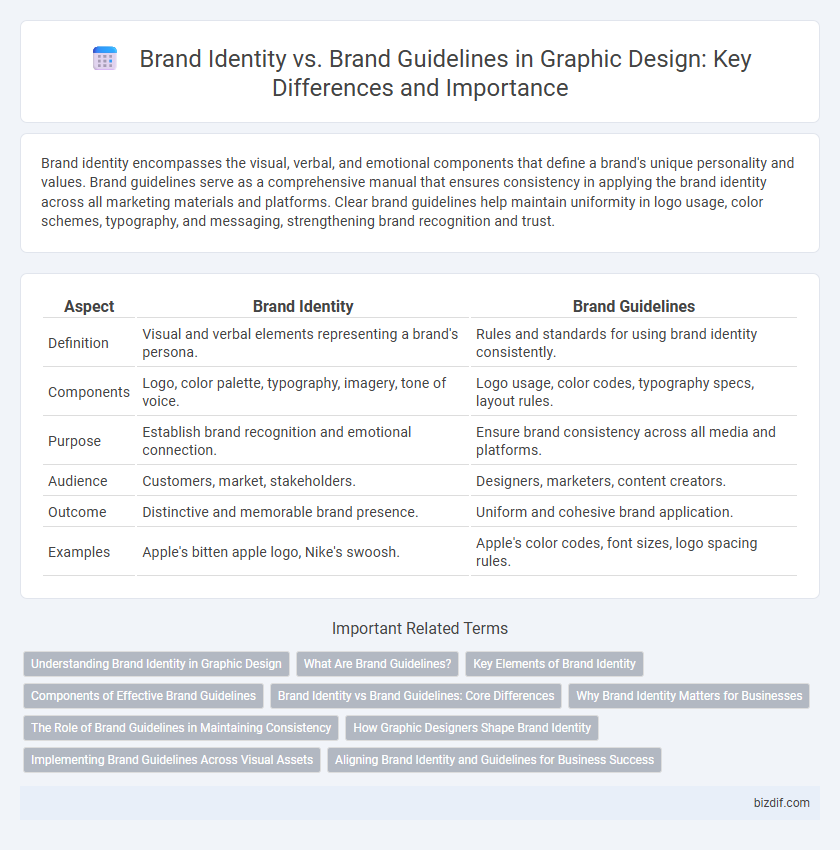Brand identity encompasses the visual, verbal, and emotional components that define a brand's unique personality and values. Brand guidelines serve as a comprehensive manual that ensures consistency in applying the brand identity across all marketing materials and platforms. Clear brand guidelines help maintain uniformity in logo usage, color schemes, typography, and messaging, strengthening brand recognition and trust.
Table of Comparison
| Aspect | Brand Identity | Brand Guidelines |
|---|---|---|
| Definition | Visual and verbal elements representing a brand's persona. | Rules and standards for using brand identity consistently. |
| Components | Logo, color palette, typography, imagery, tone of voice. | Logo usage, color codes, typography specs, layout rules. |
| Purpose | Establish brand recognition and emotional connection. | Ensure brand consistency across all media and platforms. |
| Audience | Customers, market, stakeholders. | Designers, marketers, content creators. |
| Outcome | Distinctive and memorable brand presence. | Uniform and cohesive brand application. |
| Examples | Apple's bitten apple logo, Nike's swoosh. | Apple's color codes, font sizes, logo spacing rules. |
Understanding Brand Identity in Graphic Design
Brand identity in graphic design encompasses the visual elements that represent a company's personality, including logos, color palettes, typography, and imagery. It establishes a distinct and consistent image that resonates with the target audience and differentiates the brand from competitors. Brand guidelines serve as a rulebook to ensure that the brand identity is applied consistently across all marketing materials and platforms.
What Are Brand Guidelines?
Brand guidelines are a comprehensive set of rules that define how a brand's visual and verbal elements should be presented across various platforms to ensure consistency and recognition. These guidelines include specifications for logo usage, color palettes, typography, imagery style, tone of voice, and messaging frameworks. By maintaining uniformity in design and communication, brand guidelines strengthen brand identity and build trust with the target audience.
Key Elements of Brand Identity
Brand identity encompasses the visual and emotional elements that define a company's image, including logo design, color palette, typography, and tone of voice. Key elements of brand identity create a consistent and recognizable presence that resonates with the target audience. Brand guidelines serve as the rulebook, detailing how these elements should be applied across various platforms to maintain brand consistency.
Components of Effective Brand Guidelines
Effective brand guidelines include a cohesive color palette, typography rules, logo usage, and imagery style to maintain consistent brand identity across all platforms. Clear instructions on tone of voice, messaging principles, and application examples ensure that the brand's values and visual elements are uniformly represented. These components protect brand integrity and enhance recognition by aligning design elements with strategic brand objectives.
Brand Identity vs Brand Guidelines: Core Differences
Brand identity encompasses the visual and emotional elements that define a brand, including logos, colors, typography, and tone, creating a unique image in the consumer's mind. Brand guidelines serve as a detailed manual that outlines how to consistently apply these visual and messaging components across various platforms and materials. The core difference lies in brand identity being the creative foundation, while brand guidelines act as the regulatory framework ensuring uniformity and coherence.
Why Brand Identity Matters for Businesses
Brand identity matters for businesses because it establishes a unique visual and emotional connection with customers, differentiating the company in a competitive market. A strong brand identity builds trust, fosters loyalty, and enhances recognition across all touchpoints, leading to increased customer retention and sales. Consistency in brand identity ensures messaging aligns with company values, creating a cohesive and memorable brand experience.
The Role of Brand Guidelines in Maintaining Consistency
Brand guidelines serve as a comprehensive framework that ensures consistent application of brand identity elements such as logos, color palettes, typography, and messaging across all platforms. By standardizing visual and verbal communication, brand guidelines reinforce brand recognition and build trust with the audience. Maintaining consistency through detailed brand guidelines prevents brand dilution and supports cohesive marketing strategies.
How Graphic Designers Shape Brand Identity
Graphic designers shape brand identity by crafting visual elements such as logos, color schemes, and typography that convey a brand's unique personality and values. Brand guidelines serve as detailed manuals ensuring consistent application of these elements across various media and platforms. This consistency reinforces brand recognition and builds trust with the target audience.
Implementing Brand Guidelines Across Visual Assets
Implementing brand guidelines across visual assets ensures consistent use of logos, colors, typography, and imagery that reinforce the brand identity. Clear brand guidelines provide detailed instructions for designers, enabling cohesive and recognizable visual communication across websites, social media, packaging, and advertising. Consistent application of these standards strengthens brand recognition, builds trust, and enhances overall marketing effectiveness.
Aligning Brand Identity and Guidelines for Business Success
Aligning brand identity and brand guidelines ensures a cohesive visual and verbal expression, strengthening recognition and trust across all touchpoints. Consistent application of logo usage, color palettes, typography, and messaging in brand guidelines supports the brand identity's core values and personality. This alignment drives customer loyalty, enhances market positioning, and ultimately contributes to sustained business success.
Brand identity vs Brand guidelines Infographic

 bizdif.com
bizdif.com